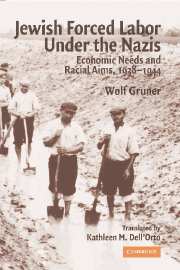Book contents
- Frontmatter
- Contents
- Abbreviations
- Introduction
- Prologue: Anti-Jewish Policies in the Nazi State before 1938
- GERMANY
- AUSTRIA
- 4 Initiatives in Vienna – Austrian Jews in the Segregated Labor Deployment Program, 1938–1945
- THE PROTECTORATE OF BOHEMIA AND MORAVIA
- THE OCCUPIED TERRITORIES OF POLAND
- Conclusion
- Index of Subjects
- Index of Persons
- Index of Places and Camps
4 - Initiatives in Vienna – Austrian Jews in the Segregated Labor Deployment Program, 1938–1945
Published online by Cambridge University Press: 05 June 2012
- Frontmatter
- Contents
- Abbreviations
- Introduction
- Prologue: Anti-Jewish Policies in the Nazi State before 1938
- GERMANY
- AUSTRIA
- 4 Initiatives in Vienna – Austrian Jews in the Segregated Labor Deployment Program, 1938–1945
- THE PROTECTORATE OF BOHEMIA AND MORAVIA
- THE OCCUPIED TERRITORIES OF POLAND
- Conclusion
- Index of Subjects
- Index of Persons
- Index of Places and Camps
Summary
ANNEXATION, ANTI-JEWISH POLICIES, AND THE LABOR MARKET
Photographs in which Jewish men and women can be seen cleaning Vienna's streets, forced to do so by the SA and SS and surrounded by curious onlookers, illustrate the reports on Austria and persecution in the Nazi era. These images of public humiliation rituals from the days after Austria's annexation to the German Reich dominate our historical memory today. At the same time, scarcely any pictures or reports from the special labor camps for Jews established after 1939 have entered public consciousness, despite the fact that thousands of Austrian Jews had to perform the most strenuous possible forced labor there for months or years. Studies on the persecution of Jews in Austria, or Vienna, ignored this subject. So far, Austrian research on the National Socialists has in fact associated forced labor with the concentration camps alone.
As already stated, the expulsion of Jewish Germans was regarded within the Nazi leadership as the uncontested objective of persecution, even after Austria's annexation in March 1938. Not until summer 1938 did the concept of forced labor surface, initially more as a spontaneous means of applying pressure, the way it was in Austria, with the objective of forcing departure. The reasons for reorienting persecutory policies emerged earlier and more noticeably in Austria than in the Old Reich, because Austrian Jews' social situation was traditionally far worse than that of German Jews and deteriorated enormously after March 1938 as an effect of brutal persecution.
- Type
- Chapter
- Information
- Jewish Forced Labor under the NazisEconomic Needs and Racial Aims, 1938–1944, pp. 105 - 138Publisher: Cambridge University PressPrint publication year: 2006



